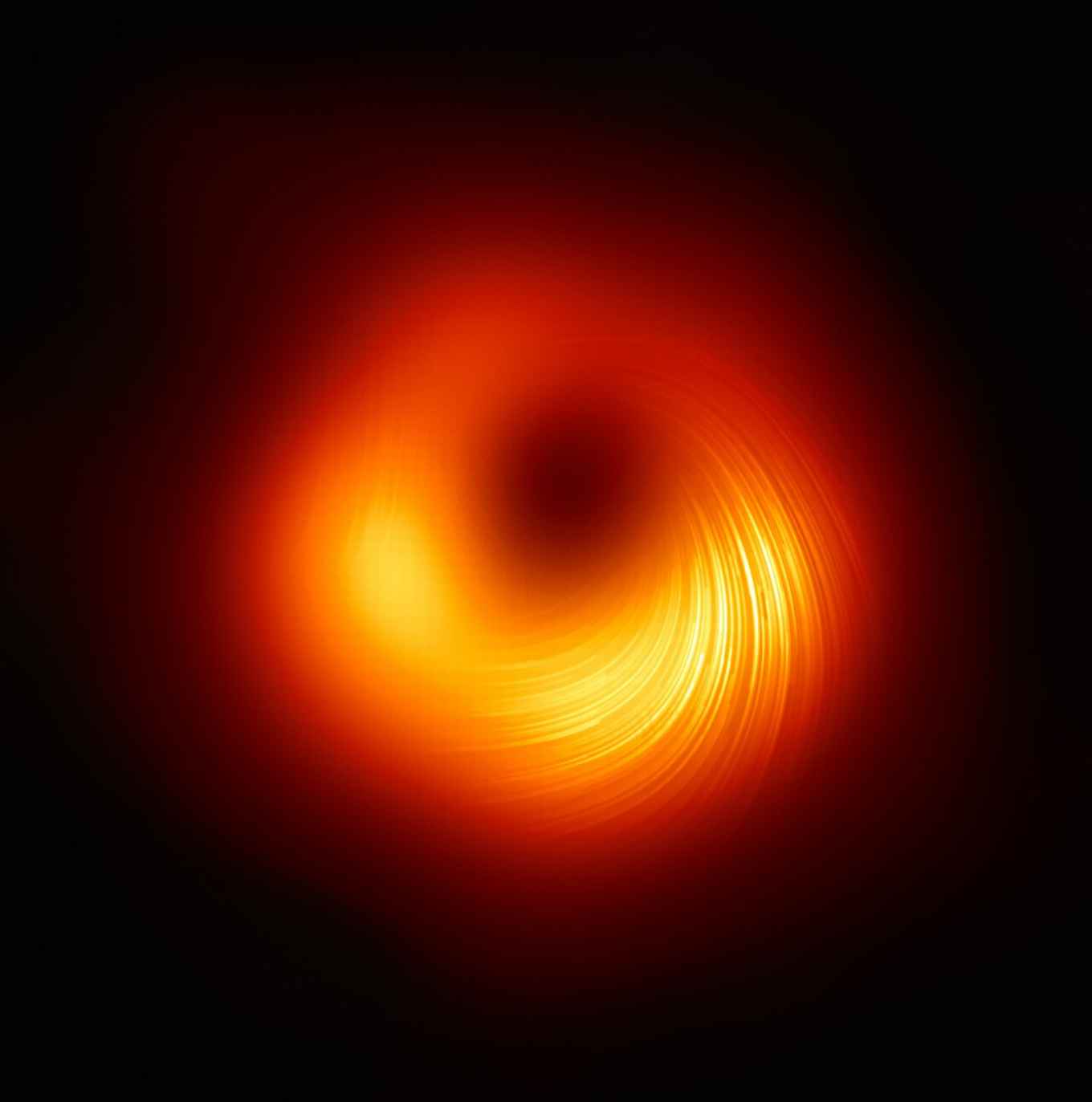Astronomers resolve magnetic fields around Black Hole M87*
29 March 2021

“These are truly sensational results!”, writes Professor Sera Markoff from the UvA’s Anton Pannekoek Institute and GRAPPA. “Not only because it has taken years to develop the analysis techniques and we can now also use these techniques on other EHT sources, but also because combining the image and the polarisation information drastically reduces the number of possible models. This in turn has implications for testing the theory of relativity and black hole accretion.”
“We have now found crucial new evidence that helps us to understand how magnetic fields behave around black holes and how activity in this very compact region of space can drive powerful jets that extend far beyond the galaxy,” says Monika Mościbrodzka, astronomer at Radboud University and Coordinator of the EHT Polarimetry Working Group.
On 10 April 2019 scientists presented the very first photograph of a black hole, showing a bright ring-like structure around a darker core: the shadow of the black hole. Since then, the EHT collaboration has delved deeper into the data collected in 2017 concerning this black hole at the heart of the M87 galaxy and discovered that a considerable fraction of the light around this black hole is polarised.
Polarisation of light
“This research represents an important milestone: the polarisation of light contains information that gives us more insight into the physics behind the photograph we saw in April 2019,” says Iván Martí-Vidal, also Coordinator of the EHT Polarimetry Working Group and GenT Distinguished Researcher at the University of Valencia in Spain. “This new image of polarised light represents years of work, due to the complexity of the techniques needed to collect and analyse the data.”
Light becomes polarised when it passes through certain filters, like the lenses of polarised sunglasses, or when it is emitted in hot regions of space that are magnetised. And just as a pair of polarised sunglasses allows us to see better by reducing reflections and glare from bright surfaces, astronomers can improve their vision of the area around a black hole by looking at how the light coming from there is polarised. To be more specific, polarisation allows astronomers to map the magnetic field lines around the edge of the black hole.
Black hole launches jets
“Our new polarised images reveal magnetic fields in extreme gravity. They help to give us a better understanding of the link between the bright ring around the black hole and the powerful jets of energy and matter that emerge from the core of M87 and extend for at least 5,000 light-years into space”, tells co-author Sara Issaoun, astronomer at Radboud University.
These jets are among the most mysterious and energetic features of the galaxy. Most of the matter close to the edge of a black hole falls in, but some of the surrounding particles escape at the last moment and are blown far out into space in the form of jets.
To better understand this process, astronomers use different models that describe how matter near to the black hole behaves. However, they still don't know exactly how jets that are larger than the galaxy itself can be launched from a central region that is smaller than our own solar system, nor exactly how matter falls into the black hole. The new EHT image of the black hole and its shadow in polarised light has enabled astronomers for the first time to examine the geometry of the area just outside the black hole, where this interaction between matter that is flowing inwards and ejected outwards takes place.
The observations give new information on the structure of the magnetic fields on the edge of the black hole. The team has found that only theoretical models that assign a major role to strongly magnetised gas can explain what they are seeing at the event horizon.
“According to the polarimetric images, the magnetic fields at the edge of the black hole are strong enough to prevent matter from falling inwards. It is easy for the gas surrounding the black hole to be blown outwards", says Mościbrodzka.
Event Horizon Telescope and ALMA
To observe the heart of the M87 galaxy, the EHT consortium linked eight telescopes around the world, including the Atacama Large Millimeter/submillimeter Array (ALMA) in northern Chile, to create a virtual Earth-sized telescope, the EHT. The impressive resolution obtained by the EHT would be enough to enable you to measure the length of a credit card laying on the surface of the moon.
“The measurements from ALMA made a crucial contribution to the interpretation of the EHT observations, which enabled us to constrain the theoretical models that describe how matter near a black hole behaves”, adds Ciriaco Goddi, astronomer at Radboud University and Leiden Observatory. He led an accompanying study based solely on ALMA observations.
Publication details
The Event Horizon Telescope Collaboration et al., First M87 Event Horizon Telescope Results VII: polarization of the ring, The Astrophysical Journal, DOI: 10.3847/2041-8213/abe71d
The Event Horizon Telescope Collaboration et al., First M87 Event Horizon Telescope Results VIII: Magnetic Field Structure Near The Event Horizon, The Astrophysical Journal. DOI: https://doi.org/10.3847/2041-8213/abe4de
Ciriaco Goddi et al., Polarimetric properties of Event Horizon Telescope targets from ALMA, The Astrophysical Journal. DOI: https://doi.org/10.3847/2041-8213/abee6a